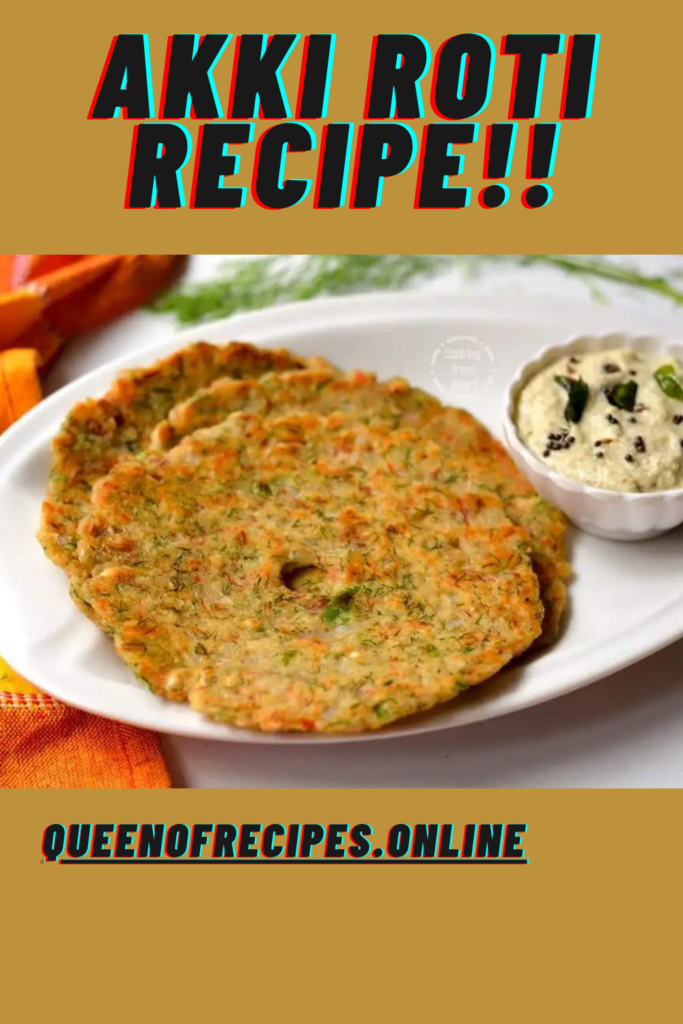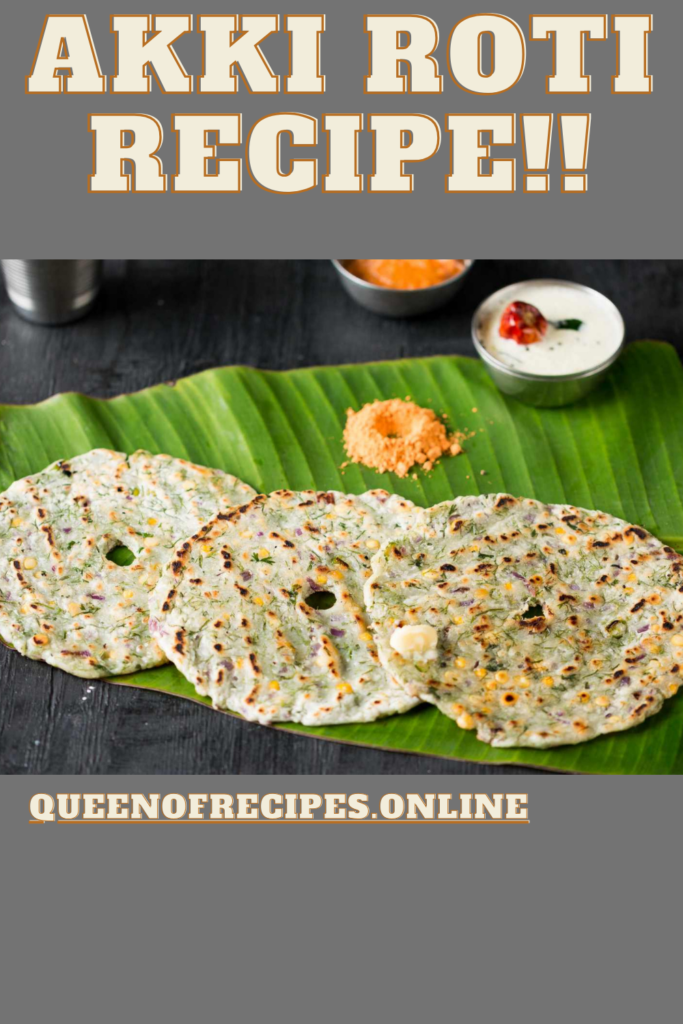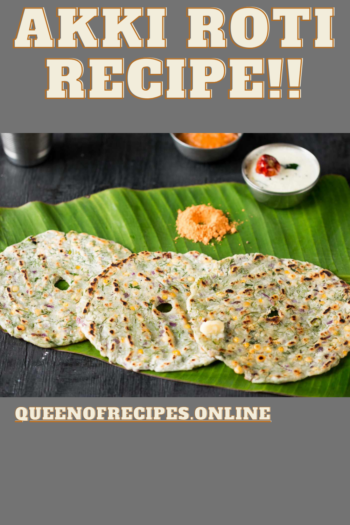Table of Contents
About Akki Roti.
Akki Roti is a traditional South Indian flatbread that originates from the state of Karnataka. “Akki” translates to rice in Kannada, the primary language of Karnataka, indicating that rice flour is the main ingredient used to make this delicious dish. It is a popular breakfast or snack option in Karnataka and is often served with a variety of accompaniments like chutney, pickle, or yogurt.
The preparation of it involves mixing rice flour with water and other ingredients like onions, green chilies, coriander leaves, and sometimes grated coconut, to form a soft and pliable dough. The dough is then divided into balls, flattened into thin rounds, and cooked on a hot griddle or skillet until golden brown and crispy on both sides.
Akki Roti offers a delightful combination of flavors and textures, with the crispiness of the outer layer contrasting beautifully with the softness within. Its versatility allows for various adaptations, with some recipes incorporating additional ingredients like grated vegetables or spices to enhance the taste.
Whether enjoyed for breakfast, lunch, or dinner, it is cherished for its simplicity, taste, and nutritional value, making it a beloved dish in South Indian cuisine.
Akki roti, a popular South Indian flatbread made from rice flour, is relatively simple to prepare at home. Here’s an easy recipe:
Ingredients for making Akki Roti:
- 1 cup rice flour
- 1/4 cup finely chopped onions
- 2 tablespoons finely chopped coriander leaves
- 2-3 green chilies, finely chopped (adjust according to your spice preference)
- 1/4 cup grated coconut (optional)
- Salt to taste
- Water as needed
- Oil or ghee for cooking
Instructions for making Akki Roti:
- Preparation: In a mixing bowl, combine the rice flour, chopped onions, coriander leaves, green chilies, grated coconut (if using), and salt. Mix well.
- Kneading the dough: Gradually add water to the mixture and knead it into a soft dough. The dough should be pliable but not too sticky. Adjust the water quantity as needed.
- Divide the dough: Divide the dough into equal-sized balls.
- Shaping the roti: Take a ball of dough and place it on a clean, flat surface. Using your fingers, pat and press the dough to flatten it into a thin, round roti. You can also use a rolling pin and roll it out gently.
- Cooking the roti: Heat a tawa or skillet over medium heat. Once hot, carefully transfer the flattened roti onto the tawa. Cook for a minute or two until small bubbles start appearing on the surface.
- Adding oil: Drizzle a little oil or ghee around the edges of the roti and also on the surface. This helps in making the roti crispy.
- Flipping the roti: Carefully flip the roti using a spatula and cook the other side. Press gently with the spatula to ensure even cooking and browning.
- Cooking thoroughly: Cook until both sides are golden brown and crispy. Ensure the roti is cooked thoroughly from inside as well.
- Repeat: Repeat the process with the remaining dough balls, adding more oil or ghee as needed.
- Serving: Serve hot Akki Roti with your favorite accompaniment such as chutney, pickle, or yogurt.
Enjoy your homemade Akki Roti!


Nutritional Value for Akki Roti.
Akki Roti, being primarily made from rice flour and often cooked with minimal oil, offers a decent nutritional profile:
- Carbohydrates: Rice flour, the main ingredient in Akki Roti, provides a significant source of carbohydrates, which are essential for energy production in the body.
- Protein: While rice flour itself is not particularly high in protein, it can still contribute some protein content, especially if paired with protein-rich accompaniments like yogurt or lentil-based curries.
- Fiber: Depending on the type of rice flour used and any additional ingredients like grated coconut or vegetables, it can contain some dietary fiber, which aids in digestion and promotes overall gut health.
- Vitamins and Minerals: It may contain small amounts of vitamins and minerals, especially if made with ingredients like onions, green chilies, and coriander leaves. These ingredients can contribute vitamins such as vitamin C, vitamin A, and various B vitamins, as well as minerals like potassium and calcium.
- Low in Fat: When cooked with minimal oil or ghee, it can be a relatively low-fat option compared to other fried or oily foods. However, the fat content may increase depending on the amount of oil or ghee used for cooking.
- Gluten-Free: Since Akki Roti is made from rice flour, it is naturally gluten-free, making it suitable for individuals with gluten sensitivities or celiac disease.
Overall, while Akki Roti may not be exceptionally high in certain nutrients, it can still be a nutritious and satisfying part of a balanced diet, especially when paired with other nutrient-rich foods like vegetables, lentils, or dairy products.
Health Benefits of Akki Roti.
Akki Roti offers several potential health benefits:
- Gluten-Free: Since Akki Roti is made from rice flour, it is naturally gluten-free, making it a suitable option for individuals with celiac disease or gluten sensitivities.
- Easily Digestible: Rice flour used in it is easily digestible, which can be beneficial for individuals with digestive issues or sensitive stomachs.
- Low in Fat: When cooked with minimal oil or ghee, it can be a low-fat option, which may contribute to weight management and overall heart health.
- Source of Energy: The carbohydrates present in it provide a steady source of energy, making it a suitable choice for breakfast or as a pre-workout snack.
- Customizable Ingredients: Akki Roti recipes often include ingredients like onions, green chilies, and coriander leaves, which not only enhance the flavor but also provide vitamins, minerals, and antioxidants essential for overall health.
- Balanced Nutrition: Depending on the accompanying ingredients and side dishes, it can be a part of a balanced meal, offering a combination of carbohydrates, protein, fiber, vitamins, and minerals.
- Versatility: It can be adapted to suit various dietary preferences and needs by incorporating different ingredients such as vegetables, lentils, or spices, making it a versatile and customizable dish.
- Cultural Significance: Enjoying traditional foods like it can promote cultural heritage and provide a sense of connection to one’s roots, contributing to overall well-being and mental health.
While it can be a nutritious and satisfying addition to a balanced diet, it’s essential to consider portion sizes and cooking methods to maximize its health benefits. Incorporating a variety of foods and maintaining a well-rounded diet is key to supporting overall health and wellness.
Tips and tricks for making Akki Roti.
Here are some tips and tricks for making delicious Akki Roti:
- Use Fresh Ingredients: Always use fresh rice flour and other ingredients like onions, green chilies, and coriander leaves for the best flavor and texture.
- Consistent Dough: Ensure that the dough for it is smooth and pliable, neither too dry nor too wet. Adjust the water quantity gradually to achieve the right consistency.
- Rest the Dough: Allow the dough to rest for a few minutes after kneading to let the rice flour absorb the moisture evenly, making it easier to roll out.
- Roll Thin Rotis: Roll out the dough into thin, even rounds for crispy and evenly cooked Akki Roti. Use a rolling pin or your hands to flatten the dough evenly.
- Hot Griddle: Preheat the griddle or skillet well before cooking the roti. A hot surface ensures that the roti cooks evenly and develops a golden-brown crust.
- Controlled Heat: Cook it over medium heat to prevent burning while ensuring thorough cooking. Adjust the heat as needed during the cooking process.
- Grease the Surface: Lightly grease the griddle or skillet with oil or ghee before cooking each roti to prevent sticking and enhance flavor.
- Press Gently: Use a spatula to press the roti gently while cooking to ensure even browning and crispiness.
- Flip Carefully: Flip the roti carefully using a spatula to avoid tearing or breaking. Cook each side until golden brown spots appear.
- Add Flavorful Ingredients: Enhance the taste of it by adding grated coconut, finely chopped vegetables, or spices like cumin seeds or ajwain to the dough.
- Serve Hot: Serve it immediately after cooking for the best taste and texture. Enjoy it with your favorite accompaniments for a delicious meal.
By following these tips and tricks, you can make perfect it at home every time, ensuring a delightful culinary experience for you and your family.


Serving Suggestions for Akki Roti.
Here are some serving suggestions for Akki Roti:
- Coconut Chutney: Serve it with a side of coconut chutney for a classic South Indian flavor combination. The creamy texture of the chutney complements the crispy roti beautifully.
- Pickle: Pair Akki Roti with your favorite pickle, such as mango pickle or lime pickle, for a tangy and spicy kick. The sharp flavors of the pickle add depth to the mild taste of the roti.
- Yogurt: Enjoy it with a dollop of fresh yogurt or raita. The cool and creamy yogurt provides a refreshing contrast to the warm and crispy roti, creating a satisfying meal.
- Spicy Curry: Serve it with a spicy curry made with lentils, vegetables, or meat. The robust flavors of the curry complement the simplicity of the roti, resulting in a hearty and fulfilling meal.
- Fresh Vegetables: Accompany it with a side of freshly sliced vegetables, such as tomatoes, cucumbers, or onions. The crisp and crunchy texture of the vegetables adds freshness and brightness to the meal.
- Herb Butter: Spread herb-infused butter or ghee on top of hot Akki Roti for an indulgent twist. The aromatic flavors of the herbs enhance the taste of the roti, making it even more delicious.
- Chutney Powder: Sprinkle homemade or store-bought chutney powder over it for a flavorful seasoning. The spicy and savory notes of the chutney powder elevate the taste of the roti, creating a satisfying snack or meal.
These serving suggestions can help enhance the taste and enjoyment of Akki Roti, making it a versatile and satisfying meal option for any occasion.
FAQs for Akki Roti.
Is Akki Roti gluten-free?



Yes, Akki Roti is gluten-free since it is primarily made from rice flour, which does not contain gluten. This makes it a suitable option for individuals with celiac disease or gluten sensitivities. Additionally, Akki Roti is often enjoyed as part of a gluten-free diet in South Indian cuisine.
Can I make Akki Roti ahead of time?



While Akki Roti is best enjoyed fresh, you can prepare the dough ahead of time and store it in the refrigerator for a few hours. However, it’s recommended to cook the roti just before serving to maintain its texture and flavor. If you need to store cooked Akki Roti, you can wrap them tightly in foil or store them in an airtight container at room temperature for a few hours. Reheat them gently on a skillet or in the microwave before serving to restore their crispiness.
How do I prevent Akki Roti from sticking to the skillet?



To prevent Akki Roti from sticking to the skillet, make sure the skillet is properly heated before placing the roti on it. Additionally, lightly grease the skillet with oil or ghee before cooking each roti. Avoid overcrowding the skillet, as this can lead to uneven cooking and sticking. If the roti does stick slightly, gently loosen it with a spatula before flipping to ensure it cooks evenly on both sides.
Is Akki Roti suitable for weight loss diets?



Akki Roti can be included in weight loss diets as it can be prepared with minimal oil or ghee, making it relatively low in fat. Additionally, it is gluten-free and made primarily from rice flour, which provides carbohydrates for energy without the added gluten. Pairing Akki Roti with healthy accompaniments like fresh vegetables or yogurt can further enhance its suitability for weight loss diets. However, portion control is important to manage calorie intake, and it’s essential to maintain a balanced diet with a variety of nutrients for overall health and weight management.

